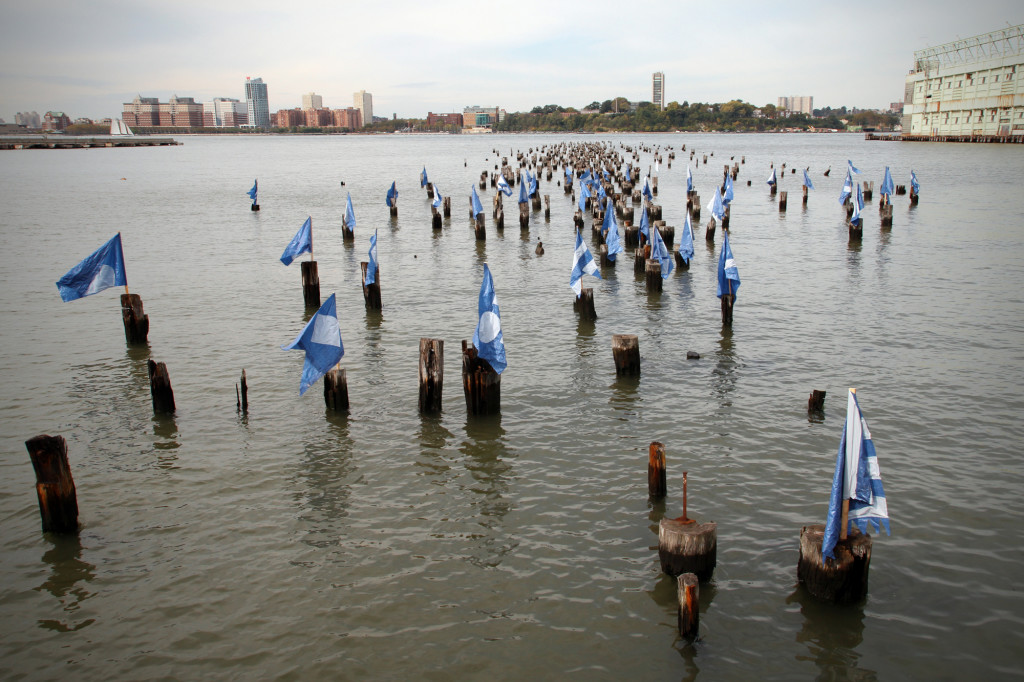
Location for installation, pilings between Pier 54 & 56, Chelsea. (photo by Chris Filippini, 2014)
What you can read here is two stories. One is a small scale story with a personal narration starring us, two protagonists, Finnish born and Berlin based artists, Milja Havas & Johannes Rantapuska. The other is a bigger scale story about the Chelsea Piers area (Meatpacking District, to be precise) and everything that lead to its change. As we initiated to intervene the scenery, we didn’t have a clue of the other story, or that these simultaneous acts would actually meet. To fully understand the bottom line of our project, these two stories cannot be told without one another. More than personal odyssey from overseas to the Hudson River, this is a story about unpredictability and change.
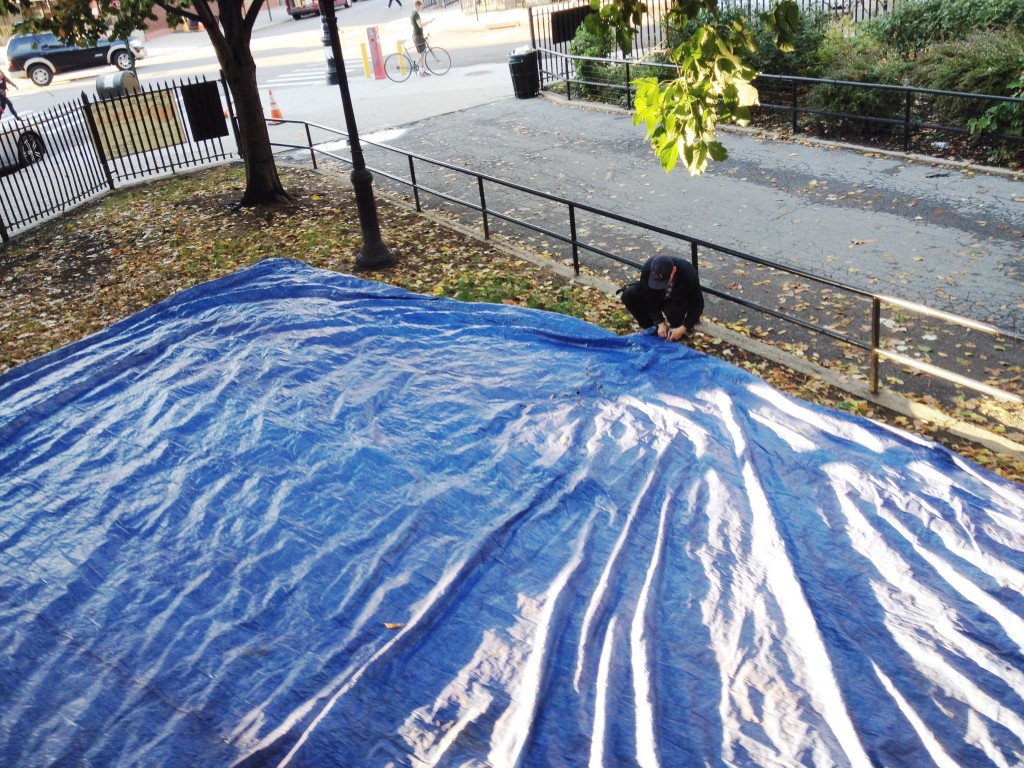
Johannes Rantapuska cutting the scavenged tarpaulin at the Monsignor McGolrick Park, Greenpoint. (photo by Milja Havas, 2014)
In the year 2013, Johannes had visited New York, and while walking aimlessly along the High Line something caught his eye. The view from above 14th Street towards the Hudson River distorted the picture perfect of the High Line so well, that a closer look was necessary. The unnumbered pier, with rotten pilings between 54 and 57, looked like a murky extension for 14th street. This remark came to life the year after when we proposed a sighting-inspired installation for the Art in Odd Places Festival. The idea was to use the pilings to create a temporary stage for several dozen flags, inspired by nautical signal flags. Instead of ships, the flags would wave for random passer-byers whose attention would be lured with the bright colors and graphic shapes. Not really having a clue how all this would be executed, we booked the flights.
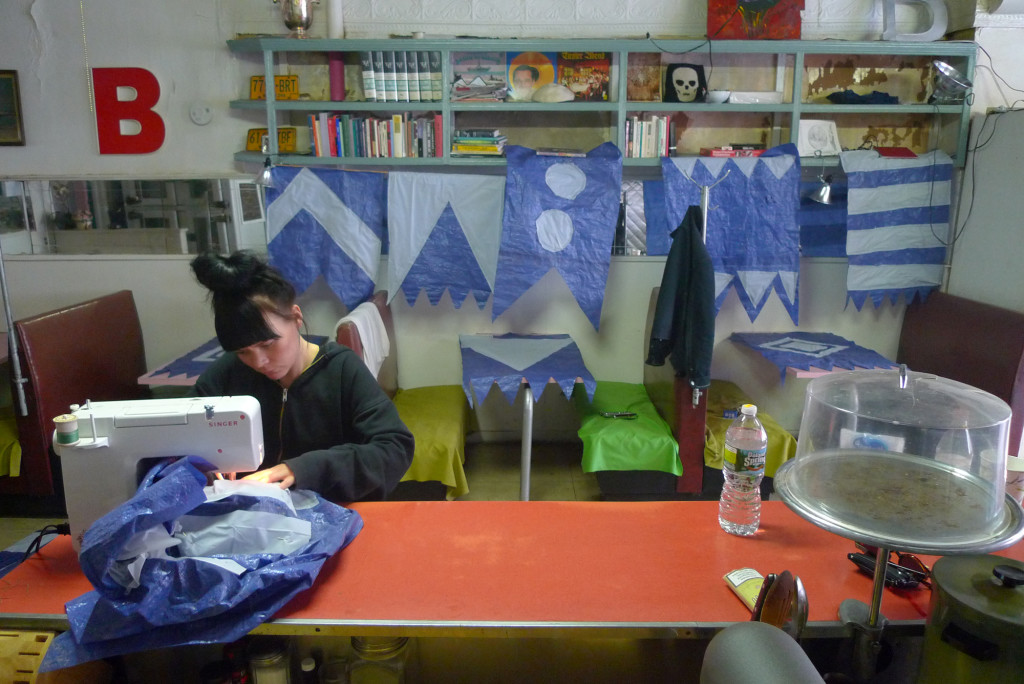
Milja Havas sewing the flags from tarpaulin. Finished flags hanging at the background. At the Sunview Luncheonette, Greenpoint. (photo by Johannes Rantapuska, 2014)
At the turn of the century, New York City revitalized the rundown and unattractive Hudson River area with Chelsea Piers. The most renowned pier of all of them must be Pier 54, at the end of the west 13th Street. Its history is connected with sunken ships, like the RMS Titanic and RMS Lusitania, Pier 54 improved its reputation c.a. hundred years later with venues such as Gay Pride and Tony Hawk’s Vert Jam. Despite the impressive background, Chelsea Pier’s caretaker, The Hudson River Park Trust, failed to raise money for its necessary repairs. During the time we arrived to New York, Pier 54 and its neighbouring piling -our target for Flux Flags-, had hardly been used for any kind of activities. Little we knew what would lie ahead.
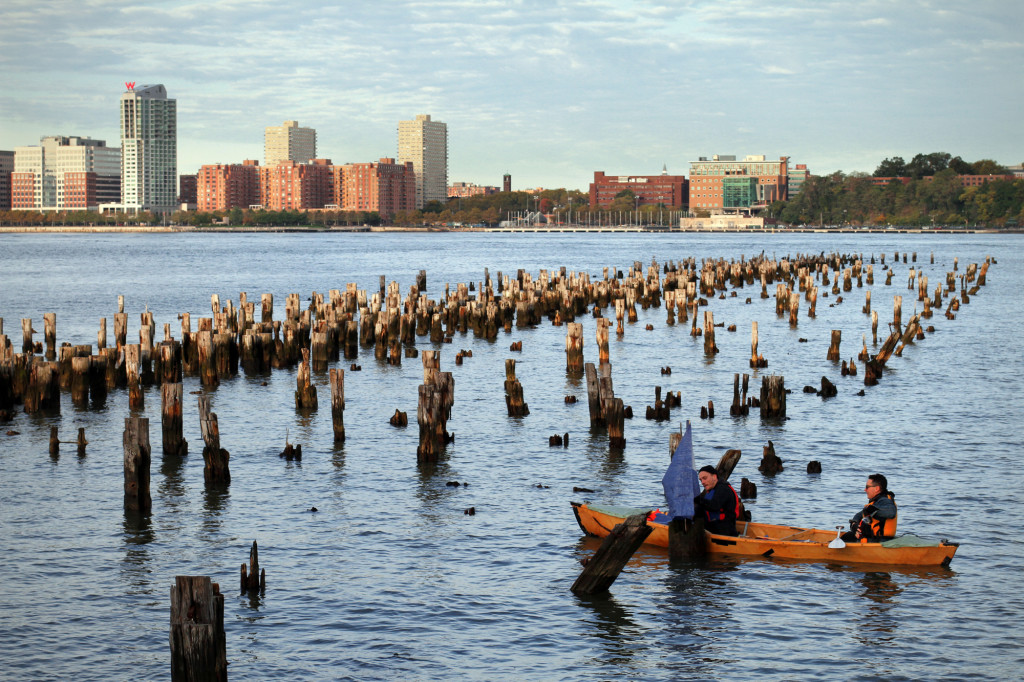
Installation day at the Chelsea Piers, with co-curator Dylan Gauthier. (Photo by Timo Sulkamo, 2014)
Flux Flags consists of approx. 70 flags that were sewn from found material such as c.a. 30m2 construction tarpaulin and several sheets of white tablecloth. Sweatshop-like laborwork paid off as we one brisk morning we laid canoe to the water, heading towards the pilings. Together with our curator, Dylan Gauthier, we navigated between narrow pile rows, one hand on a paddle keeping the sharp lumber away, while other hand holding the flag ready to attach it on any favorable surface. Our aim was to use the untapped part of the waterfront as a stage for unexpected spectacle. Right at the core of Manhattan, next to a busy driveway and jogging route, the location played a nice attention catcher from the side that often stays unoticed. If New Yorkers had turned their backs on the sea, Flux Flags was an temprorary attempt to turn them over again. According to the constant photo opportunities, we did a good job.
Encouraged by the successful installation for AiOP 2014, we were glad to accept the invitation to reinstall Flux Flags for upcoming AiOP 2015: Recall. After all, doing it once the harder way, this time everything should go by the book, right? Scavenged tarpaul replaced with pre-sewn flags, personal budget with a travel grant, and trial-and-error with been-there-done-that, our confidence was high. Something you could call as positive arrogance. But when it comes to public interventions, it is as uncertain as the weather.
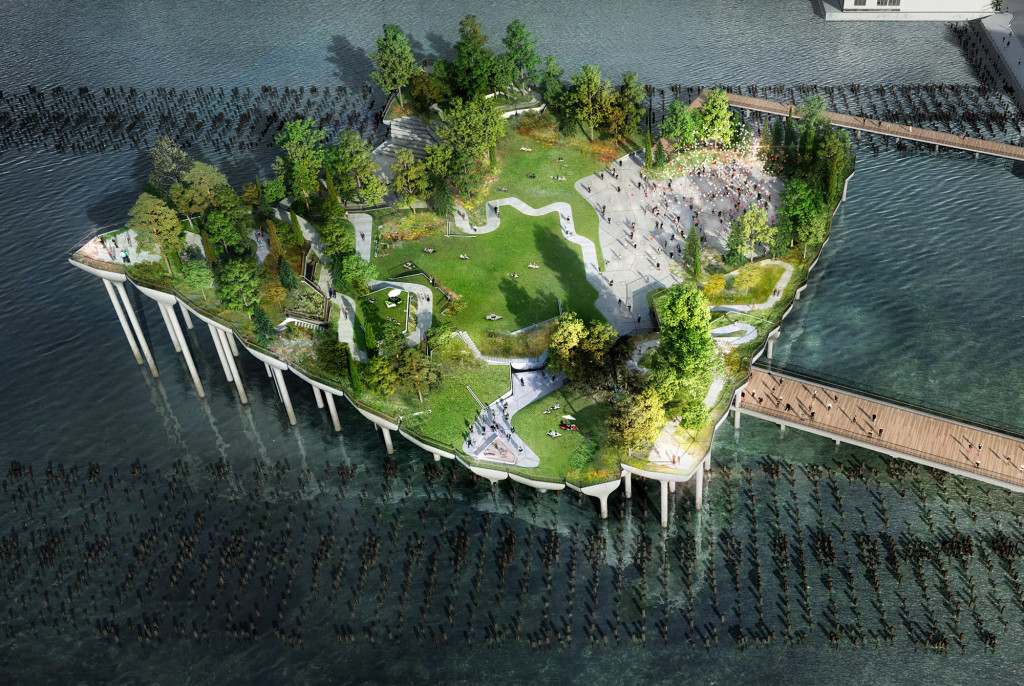
Rendering for upcoming floating park, Pier55. (image courtesy Pier55 Inc./Heatherwick Studio. All images copyright Heatherwick Studio. Images are provided for editorial use and only in direct connection with the Pier55 project.)
2015 is end of an era for Chelsea Piers’ Meatpacking District. On november the 2014, Hudson River Park Trust signed an agreement together with the Diller – Von Furstenberg Family Foundation to build a new park above the remnants of Pier 54. The new 130 million dollar floating park, Pier55, is scheduled to see daylight on 2019. The plan includes the demolition of pier 54 and (state-funded) extension for the existing esplanade that also leads to the park. The park itself will also consist of a performance stage. The billionaire power couple Barry Diller and Diane Von Furstenberg are previously known for their generous donations a stone’s throw away, The High Line park. The 113 million dollar donation for Pier55 will be declared as the single largest private donation to a public park in New York City history. At the moment, the floating island project is halted by civic group lawsuits. They claim that the project failed to conduct a required environmental review.

Piers 54-56 already under construction during the planned re-installation day. (photo by Milja Havas, 2015)
This year we went to see the original site, only to realize that the transformation of the pier has already started. The archway of Pier 54 was peeled off, leaving only the rusty historic gate in its place, and turning the rest into a mirror image of its neighboring pilings. Between Pier 54 and designated Flux Flags pilings, there was also a huge construction raft with all the neccessary equipment, including a crane, containers, and handful of workers. Despite the civic group lawsuits, the construction was already in full effect and the first part, the extended esplanade, is expected to be finalized during in 2016. All this meant that we were late. The drastic change of the scenery, combined with the bad luck of getting a canoe, made our reinstallation attempts futile. By choosing this specific area for artistic practise, Flux Flags drew the curtains before the second act. This is the play where the Diller – Von Furstenberg Family Foundation steps into the spotlight. Our original idea of an aesthetic attention catcher for a rarely observed site ended up birthing more content that we could have ever imagined. A collission between two parallel stories emerged, a new continuum to the original story that we never intended to tell. The essence of public art is to be temporary and consantly on the flux, which applies to flags.

